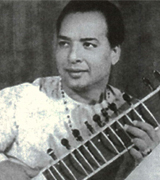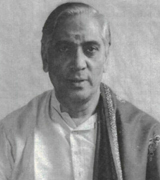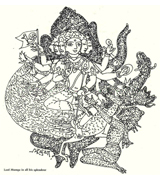Special Feature
Ustad Vilayat Khan

The Man And His Music
Praising Ustad Vilayat Khan is easy, but not necessary. Understanding him is necessary, but not easy. While he was amongst us, superlatives passed off as interpretation. With his departure, the task of explaining his awesome influence must begin. Those who have interacted closely with the Ustad, and invested considerable effort in understanding him, have an important contribution to make to this task. This essay is a small attempt in this direction by one so privileged. For the confidence with which I make my observations here, I am deeply indebted to friends who have helped me acquire a substantial archive of Vilayat Khan's music, and to the guidance of my Guru, Pt. Arvind Parikh, the Ustad's seniormost disciple.
The personality
Vilayat Khan's was a personality shaped by the conviction that it was destined to leave its mark on the world. He would not have been happy with just being the greatest sitarist; he had to be amongst the all-time greats of Hindustani music. This set him on a path of passionate absorption of the tradition, unrelenting innovation and the pursuit of superhuman standards of perfection in the execution of his musical vision.
Main Feature
Bhagavatula Seetarama Sarma

To those who had the pleasure of would readily acknowledge his contribution witnessing the performances, to the institution. After he left Kalakshetra particularly the dance-dramas, of Kalakshetra in 1985, he started his own teaching in the sixties and the seventies, the names institution. Kala Peetham. The bright young of Kamala Rani and Bhagavatula Seetarama star of today's Carnatic music firmament, Sarma will indeed be familiar. They were T.M. Krishna is his sishya and dancers the backbone, providing music and Revathi Ramachandran and Jayanthi nattuvangam. Kamala Rani passed away recently. Seetarama Sarma who came from the village of Koochipoodi (which is how the name of the village and the dance-form should be written and pronounced) with a background of dance and Carnatic music, was moulded by Kalakshetra
Book Shelf
Ragas At A Glance
Prof. S.R. Janakiraman, a major force in the field of musicology for several decades whose grey cells seem to work overtime, has authored the book Ragas At A Glance, giving relevant details of 150 janaka and janya raga-s. The individual characteristics of some of the popular raga-s are given, although the selection cannot be exhaustive as raga-s are innumerable, 'Anantascharagah' as the Sanskrit phrase says. Eka kriti raga-s like Chittaranjani, Manjari, Madhava Manohari, Kutoohalam, Poornapanchama and others belonging to this category are discussed. Very rare melodies such as Kanakakusumavali, Ragapanjaram, Varada and Vivardhani among others, old raga-s of mediaeval origin and new scales of recent origin are highlighted. Raga-s with no traceable compositions, but known by name and scale, are not included in this volume. Only those that have at least one known composition to their credit are mentioned. The raga-s are described only with reference to the 12 swarasthana-s or 16 swara-s, as the case may be, and the characteristic sruti-s figuring in some raga-s have been referred to as and when appropriate. Raga-s suited to different kinds of compositions and their standing in the various spheres of music are pertinent observations.
A Series For Youngsters
Arunagirinatha

Tiruppugazh means praise of god. One of the places visited by Arunagiri was Vayalur in the district of Tiruchirapalli. It is said that here Arunagiri, desiring to sing more and more in praise of Lord Muruga, sought the Lord's permission to pray first to Poyya Ganapati of Vayalur and get his blessings. Arunagiri, in one of his songs, says that Lord Poyya Ganapati appeared in his dream and blessed him to sing the 'Tiruppugazh' (divine praise) on Lord Muruga's vehicle (vahana), the peacock, his flag with the cock emblem, his two feet, twelve shoulders and on Vayalur. Thus it is believed that it was Lord Poyya Ganapati who christened Arunagiri's compositions Tiruppugazh. His poems and songs have attracted the admiration of many later scholars and saints. Tayummanavar, a saint of later times, remarked "vaakkirku Arunagiri" meaning that for beauty of words


